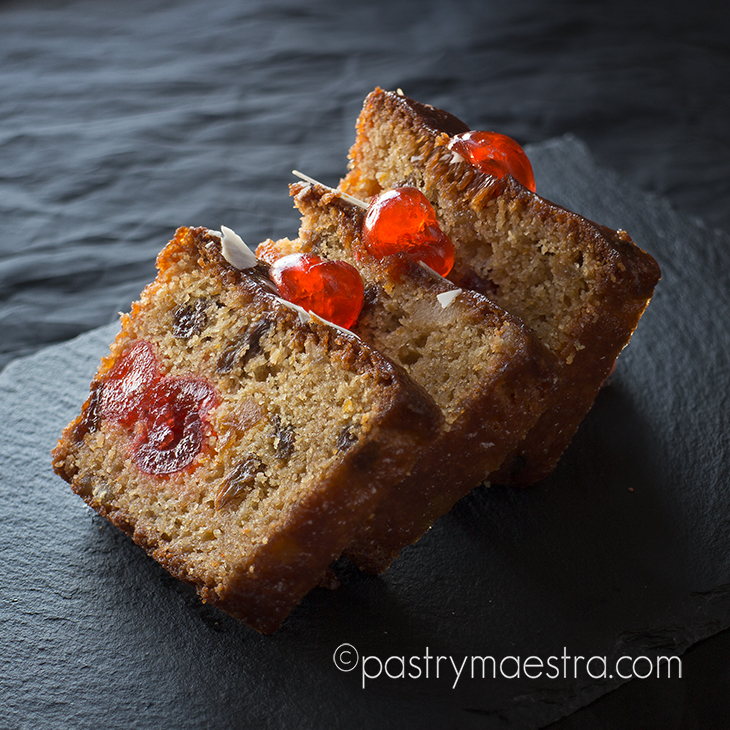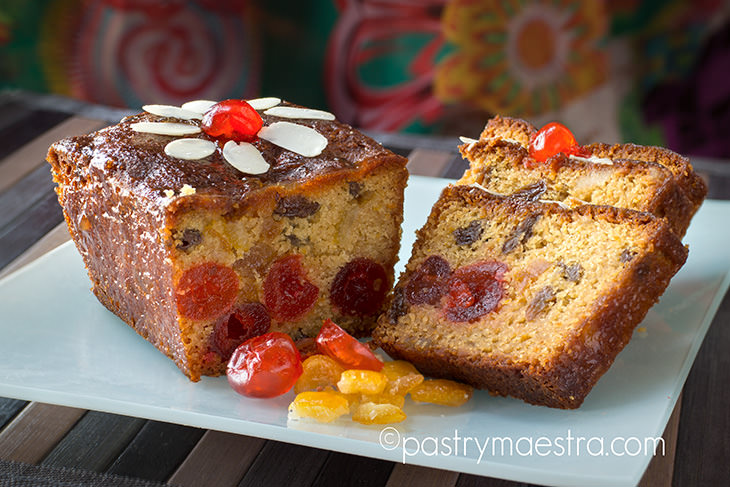F
ruitcake is a rich cake that contains lots of dried or candied fruit, nuts, and spices. There is one more essential ingredient necessary for making this traditional dessert usually served at Christmas time, or for weddings and other festive occasions, and I will tell you which one. It’s alcohol! Or – to be more precise – brandy or whiskey (although I prefer rum, so I am using it in my recipe). These spirits are used to “feed” fruitcake for significant period – meaning a few months or even whole year after the cake is baked! Soaking the cake in alcohol prolongs its shelf life, and also contributes developing the flavor, so the longer fruitcake is fed, it will be more appreciated, and more expensive, of course. Fruitcake can be brushed with jam and coated with a layer of marzipan (almond paste), or it can be iced and decorated with royal icing – pure white icing made of egg whites and powdered sugar.

It is believed that fruitcake dates back to ancient Rome when pomegranate seeds, pine nuts, and raisins were mixed into barley mash and shaped into a ring. Later, in the Middle Ages, honey, spices, and preserved fruits were added to this mixture.
The “stollen” a German fruitcake, was developed in the mid-1300s, and has been served at Christmas time from its conception. Fruit cakes quickly became popular all over Europe. Recipes varied greatly in different countries throughout the ages, depending on the available ingredients, as well as – church regulations forbidding the use of butter, because, being an animal product it interfered with fasting. Let me mention that during the fasting, the sugar was forbidden too! A fruitcake WITHOUT butter AND sugar??!! I’ll pass, thank you! Anyway, In Medieval Saxony (now central Germany), Prince Elector Ernst and his brother, Duke Albrecht, decided to change this rule, so – they wrote to the Pope! It took them FIVE popes to have their pleas answered! Finally, in 1490 Pope Innocent VIII sent them a response — known as “The Butter Letter” — which granted the use of butter for their baked goods without having to pay a fine – but only for their household! The Pope was clever and put a condition in the letter stating that others could also use butter for cooking, but whenever butter was used, a donation had to be made to help with the cost of constructing the Freiberg Cathedral. In France, a special collection box was placed in French parishes to collect butter money, which may have been used to fund the construction of new towers for big cathedrals like those in Rouen and Borges, known to locals as the “Tour de Buerre” or “Butter Tower.”
I will not get into details now, but some historians claim that this problem was one of the main reasons for Martin Luther to break ties with Rome and the result was what we know today as – Protestantism. Anyway- back to the fruitcake! Starting in the 16th century, sugar from the American Colonies – and the discovery that high concentrations of sugar could preserve fruits for a long time – created loads of candied fruit, thus making fruit cakes more affordable and popular. By the early 18th century, fruitcake, also called plum cake, became synonymous with decadence and was outlawed in Europe, where it was proclaimed “sinfully rich”. Luckily, the law didn’t hold since fruitcake had become an important part of the tea time ritual, especially in England – a Victorian “Tea” simply would not have been complete without the addition of the fruitcake to the sweet and savory snacks! And, fast forward to today – we have various types of butter – more about that you can learn from my post about buttercream.
Today, at traditional English weddings, you can find rich, dense fruitcakes packed with all kinds of dried fruits, under white fondant and sugar flowers. One of the most wonderful examples of this technique is a magnificent eight tiered cake crafted by cake-maker Fiona Cairns for royal wedding of Prince William and his bride Catherine, Duchess of Cambridge in 2011. The interesting fact is that one of their guests sold his piece of royal wedding cake three years later for astonishing $7.500! One more interesting – I would even say bizarre – fact, is that a piece of cake from the wedding of Princess Diana and Prince Charles a few years ago was sold at auction for approximately $6.000, and the cake was 27 years old at the time! I guess that is the reason for the term “nutty as a fruitcake”…
Anyway, I am giving you a recipe for a rich fruitcake, and this one contains only small amount of rum. You can sprinkle the fruitcake with some more alcohol if you want, after it is done. Roll up your sleeves and get baking! And please, don’t wait 27 years to taste your fruitcake!

Fruitcake Recipe
by:Tereza Alabanda,The Pastry Maestra
PRINT PDF (EN) ISPIŠI PDF (HR)Prep. time : 25 minutes
Cook time : 35 minutes
Ready in 60 minutes
Level : Basic
Ingredients:- Butter 125g (4.4z)
- Sugar 50g (1.8oz)
- Demerara sugar (light brown) 30g (1oz)
- Dark muscovado sugar 30g (1oz)
- Grated zest of one orange
- Eggs 100g (3.5oz or 2 medium eggs)
- All purpose flour 100g (3.5oz)
- Almond flour 50g (1.8oz)
- Baking powder 5g (1Tsp)
- Raisins 60g (2.1oz)
- Rum 30g (2Tbsp)
- Dried apricots 50g (1.8oz)
- Candied orange peel 50g (1.8oz)
- Candied cherries 100g (3.5oz)
- Extra rum for brushing
- Apricot jam 150g (5.3oz)
- Soak raisins in rum, if possible overnight
- Mix the butter, sugar, demerara (light brown) sugar, muscovado sugar and orange zest until the mixture becomes creamy.
- Add eggs gradually, and mix until the mixture becomes uniform.
- Fold in sifted flour, almond flour and baking powder with spatula and add dried and candied fruits in the end.
- Fill two 15cm x 9cm (approximately 6″ x 4″) cake pans with the batter.
- Bake at 160ºC (320°F) for about 35 minutes, until golden brown and the cake tester or toothpick comes out clean when inserted into the cake.
- Brush whole cake with extra rum.
- Heat up apricot jam mixed with 1 tablespoon of hot water. Brush the fruitcake with warm jam while it is still hot and decorate it with some extra fruits and nuts.
Copyright© PastryMaestra.comTM
Well, what do you think about this post?
Please leave your comment on YouTube, thank you!
I read and really appreciate all the comments, even though I do not always have the time to respond to each one. So – keep me in the loop and try to create some sweetness every day because – Sweetness is happiness!!




